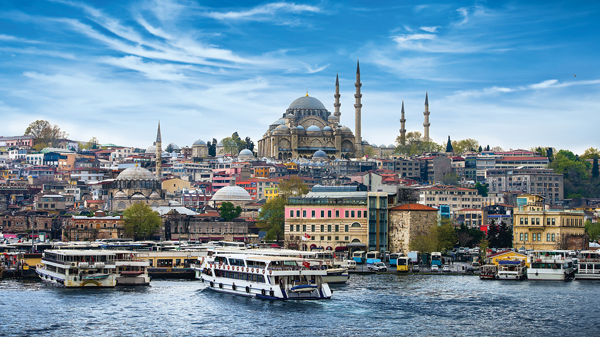There’s a greatness to Istanbul. Built on the banks of the Bosporus, straddling Europe on one side and Asia on the other, this ancient Turkish city carries with it a special ambience all on its own. Hüzün is the word Nobel-Prize-winning Turkish writer, Orhan Pamuk, uses to describe the city in which he was born and bred. It’s a common melancholy experienced by the people of Istanbul arising out of the collapse of the mighty Ottoman Empire, a longing for the way things were. But rather than succumb to the feeling, many Istanbulites celebrate it, romanticise it – it’s a sense of deep spiritual loss but also an optimistic way of looking at life.

Fortunately for the intrepid visitor, Istanbul – and indeed this vast country’s appeal – remains intact and travellers will be heartily welcomed by Turks into the bosom of this vibrant, thriving metropolis.
Blue Heaven
Much of Istanbul’s skyline is dominated by the imposing, but nonetheless picturesque Blue Mosque, shortage of mosques in the city, this is arguably the finest. Constructed in the late seventeenth century, it is the culmination of Ottoman Empire architectural excellence and is considered the last great mosque of the classic period. Painstakingly hand-painted blue tiles embellish the mosque’s interior walls, while at night the facade takes on a whole new atmosphere as it is bathed in an eerie blue as a bank of lights accentuates the mosque’s 13 domes and six minarets.

From afar the slender minarets give the Blue Mosque a decided delicate look, but up close it’s easy to see what a splendidly constructed creation it is. Breathtaking inside and out, it shouldn’t be missed. But it should be remembered that this is also a place of worship. For the considerate visitor, it’s essential to follow the rules of entry, which requires a modest dress sense – meaning no unnecessary showing of bare skin.

Bazaar Bonanza
It is perhaps as a shopping Mecca that Istanbul comes truly into its own, and there is no better place to start than the Grand Bazaar. Doing a brisk trade since the mid-fifteenth century, it positions itself as a medieval version of the modern-day shopping mall. The bedestens (warehouses) and caravanserais, which are connected by vault-roofed lanes – harking back to a Turkey of a bygone era – contain upwards of 4000 stores. There’s a veritable potpourri of Turkish crafts on show and on sale, in addition to craftwork from central Asia and the Middle East. Everything from traditional handloom Turkish carpets, to superb handcrafted gold jewellery.

Continuing with a more up-market theme, Istiklal Caddesi boasts an impressive number of international high-street brands, set amid a backdrop of neoclassical buildings. The most famous of which is the Çiçek Pasaj (Flower Passage), where small boutique stores sell beautiful hand-woven shawls, vibrantly coloured ceramics and lamps, and much more among a slew of other. Then, give your feet a rest by catching one of the area’s vintage trams, providing a quaint, relaxing ride all the way up to Taksim Square.

Foodies’ Paradise
For something to get the olfactory senses humming, explore the Egyptian Spice Bazaar. Built in the seventeenth century from tax dollars winkled out of Ottoman-occupied Egypt, this souk is a feast for the senses. The shops here sell an unbelievable variety of spices, dried fruit and nuts. For sweet tooths, there are local treats like helva and lokum (Turkish delight). It’s the perfect place to stock up on spices that are essential to Turkish cuisine, such as sumac and Aleppo pepper, as well as high-quality pomegranate molasses (the Turkish equivalent of MSG) and an impressive array of delicious Turkish honeys.

If you’re feeling a little piqued after your bazaar odyssey, right next to the spice bazaar is the Kurukahveci Mehmet Efendi, one of the country’s pre-eminent coffee producers since 1871. Grab a fortifying cup of a rich and strong brew and pick up your own packet of authentic Turkish coffee. It’s a must-try for caffeine aficionados.
Turkish food, is of course, famous the world over. And there is no better place to sample the mouth-watering foodstuffs than Istanbul. If it’s a top-notch meal you’re after, the improbably named Buhara Fish Meat House Roof offers authentic Turkish cuisine in an al fresco roof-top setting. While for Turkish desserts, Şekerci Cafer Erol Galataport offers an embarrassment of mouth-watering sweet riches and comes highly recommended.

Once you’re suitably sated, why not grab a little fresh air with one of the world’s most spectacular ferry rides, across the Bosporus, affording a unique visual take on the city. It’s also a body of water steeped in history with the Turks eventually wresting the city from the Greeks, with control of the Bosporus Strait a strategic stronghold. Constantinople officially became Istanbul in 1930.

Fairy Chimneys of Cappadocia
Once you’ve soaked up the sights, sounds and tastes of Istanbul, it’s just a short plane ride to Cappadocia – one of the hottest tickets in this endlessly fascinating country. Located in central Turkey, Cappadocia is famous for its otherworldly landscape, most notably its fairy chimneys – tall, cone-shaped rock formations that are commonly found in Monks Valley and Göreme. It’s well worth spending a day or two exploring these extraordinary natural wonders on foot.

Incredibly, people live in these fairy chimneys and have done for thousands of years. The soft rock is made up of sandstone, which can be scratched away and shaped with a suitable tool or even by hand. Once water is applied to the carved-out material, it hardens like clay, making an ideal home for the local inhabitants and giving shelter from the semi-arid and occasionally inhospitable environment.

Come Fly With Me
The next thing the dauntless traveller should do in Cappadocia is to take to the skies and take a different perspective of this outlandish landscape by hot air balloon. There’s no better way to take in the expansive vista than with a bird’s-eye view. The best conditions for take-off and flying – or is it floating? – is in the early morning so be prepared to rise early. But you will be rewarded by seeing the sun rise over this surreal landscape.
Most tours will pick you up from your hotel and breakfast is provided once airborne. Premium packages are also available. The balloons can fly close to the ground due to a lack of wildlife and afford up-close-and-personal views of this whacky and wonderful terrain. Have your camera at the ready for some unforgettable snaps.







